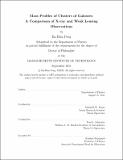| dc.contributor.advisor | Marshall W. Bautz and Paul L. Schechter. | en_US |
| dc.contributor.author | Peng, En-Hsin | en_US |
| dc.contributor.other | Massachusetts Institute of Technology. Dept. of Physics. | en_US |
| dc.date.accessioned | 2013-03-01T14:33:23Z | |
| dc.date.available | 2013-03-01T14:33:23Z | |
| dc.date.copyright | 2011 | en_US |
| dc.date.issued | 2011 | en_US |
| dc.identifier.uri | http://hdl.handle.net/1721.1/77252 | |
| dc.description | Thesis (Ph. D.)--Massachusetts Institute of Technology, Dept. of Physics, 2011. | en_US |
| dc.description | This electronic version was submitted by the student author. The certified thesis is available in the Institute Archives and Special Collections. | en_US |
| dc.description | Cataloged from student-submitted PDF version of thesis. | en_US |
| dc.description | Includes bibliographical references (p. 149-163). | en_US |
| dc.description.abstract | Clusters of galaxies are useful probes of cosmology because they are the most massive bound systems and fair representatives of the matter composition of the universe. For clusters to be used as tracers of cosmic evolution, one must determine their masses with high accuracy. In this thesis, we provide a detailed comparison of mass estimates from X-rays and weak gravitational lensing for a sample of 32 intermediate low redshift clusters, and study the dependence of the mass profiles derived from these techniques on the dynamical state of the clusters. We analyze Chandra X-ray observations and compare the X-ray masses with published weak lensing data (Hoekstra, 2007; Okabe et al., 2010). The temperature, gas density, pressure, gas fraction profiles and their relation to the cluster morphology are also examined. We find that slopes of X-ray pressure and mass profiles vary with cluster morphology. Specifically, clusters with lower third-order power ratios P3=P0 (more relaxed) have the steepest profiles while high P3/P0 clusters (more disturbed) have the attest ones. The same trend is not obvious in weak lensing data. Consequently, a correlation between P3/P0 and the mass ratio of X-ray to weak lensing estimates MX/MWL, which in principle indicates the level of non-thermal pressure component in clusters, is found. For the entire sample, we find MX/MWL = 1.14±0.12 at R2500 (at 68% confidence). For apparently unrelaxed, high P3/P0 clusters, we find MX/MWL = 0.96 ± 0.12 at the same radius. For apparently relaxed, low P3/P0 clusters, we find MX/MWL = 1.32 ± 0.17, instead of MX/MWL = 1, expected if these clusters are in hydrostatic equilibrium. This may imply that the gas is hotter than the dark matter in cluster central regions (Rasia et al., 2004).. | en_US |
| dc.description.statementofresponsibility | by En-Hsin Peng. | en_US |
| dc.format.extent | 163 p. | en_US |
| dc.language.iso | eng | en_US |
| dc.publisher | Massachusetts Institute of Technology | en_US |
| dc.rights | M.I.T. theses are protected by
copyright. They may be viewed from this source for any purpose, but
reproduction or distribution in any format is prohibited without written
permission. See provided URL for inquiries about permission. | en_US |
| dc.rights.uri | http://dspace.mit.edu/handle/1721.1/7582 | en_US |
| dc.subject | Physics. | en_US |
| dc.title | Mass profiles of clusters of galaxies : a comparison of X-ray and weak lensing observations | en_US |
| dc.type | Thesis | en_US |
| dc.description.degree | Ph.D. | en_US |
| dc.contributor.department | Massachusetts Institute of Technology. Department of Physics | |
| dc.identifier.oclc | 827279700 | en_US |
